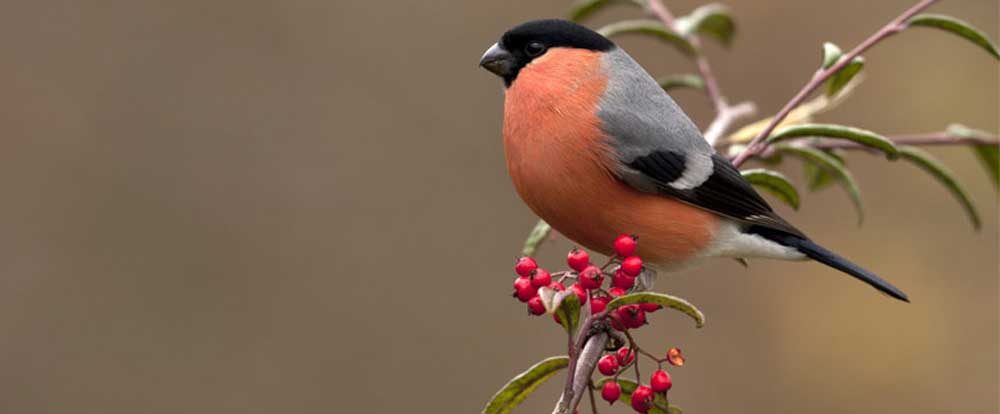The bullfinch is known for its distinctive appearance, as it has a stocky body and chunky head with a black cap. It’s front-heavy appearance and thick neck is similar to that of a bull, thus the name “bullfinch”.
With a bright, pinky-red breast, the male bird is easily recognisable when he visits your garden. The female’s breast is a more muted, neutral, buff shade, but both males and females have a grey back, white rump and black tail.
The bullfinch is a member of the passerine family of birds – also known as perching birds or songbirds. It was kept as a pet in bygone times, due to its beautiful and melodic singing voice. Today, quite rightly, it’s more likely to be found flying free in the wild, rather than in a cage entertaining visitors in someone’s parlour!
When was the bullfinch discovered?
Although the first official mention of the bullfinch was made in a European nature book in the 18th century, the bird’s ancestors date back around 12,000 years to Portugal, according to a recent scientific find.
An international team of researchers exploring the island of Graciosa, in the Atlantic Ocean’s Azores archipelago off the coast of Portugal, have discovered the remains of an extinct species of bullfinch called Pyrrhula Crassa.
Its bones were found in a cavity inside a volcano through which lava once flowed. The bird was still in existence up to a few hundred years ago, but died out due to people colonising the islands and introducing invasive wildlife species.
The bullfinch was officially recognised for the first time by the Swedish zoologist Carl Linnaeus in his 1758 book, Systema Naturae. As one of his major works, the book launched the practice of scientifically naming animals.
British academic William Burley Lockwood studied the etymology of bird names and published a factual book, The Oxford Dictionary of British Bird Names, in 1984. He said the bullfinch was named in the same way as the “bullfrog” and “bulldog” in recognition of its “literally bull-headed” build. He noted the bird’s “neckless rotundity”.
Also known as the Pyrrhula Pyrrhula, the bullfinch lives across the UK today. Its Latin name comes from the Greek word “purrhoulas”, which means “worm eating bird”. The species has spread across large areas, stretching from Ireland to northern Europe and beyond, as far as Japan.
When can you see the bullfinch?
The bullfinch is around in the UK all year round. An unobtrusive and quiet species, which congregates in small, loose flocks or in pairs, it can also be seen on its own foraging for food. It is often overlooked in summer, when our gardens are busy with other birds.
The bullfinch is not a regular garden visitor as a rule. It inhabits agricultural farmland, woodland areas, coniferous forests and parks, and can live in blackthorn and hawthorn hedges, or in fruit orchards. Being a shy species, it is seldom found in areas of open space and rarely ventures into gardens.
According to the Birdwatch study, run by the British Trust for Ornithology, only 10% of people taking part reported seeing a bullfinch in their own garden. In summer, as natural food supplies increase, they are less likely to be found venturing into gardens.
It may be more easily spotted during the winter months, when small flocks of bullfinch will arrive at feeding sites, often travelling in smaller family groups.
During the spring, the bullfinch likes to feed on the buds of fruiting trees and is sometimes considered to be a pest, as it damages the crop. With a diet that consists of mostly seeds and plants, such as nettles, ash and elm, it will also eat fruit from trees and bushes. In particular, it enjoys fleshy fruits, such as raspberries and strawberries.
When it forages for worms or insects, this is mainly to feed fledglings. If you’re hoping to attract the elusive bullfinch to a garden feeding table, sunflower seeds and raisins are among their favourite foods.
Making a nest from twigs, moss and lichens, the bullfinch normally mates for life. A bonded pair will lay up to five eggs at a time, on at least two occasions, during the breeding season from April to August.
Is the bullfinch an endangered species?
The bullfinch suffered a population decline in the latter part of the 20th century, but it is gradually making a comeback. However, its population remains 36% lower than it was in 1967, according to the Beyond the Maps research programme, organised by the British Trust for Ornithology.
The study cites the fact that the bullfinch has lost much of its habitat to agricultural growth. Today, it is listed as an “amber” status species – its population has suffered a decline, but numbers are now starting to recover, although it is still not classed as safe.
Primarily, population increases have occurred in some parts of Scotland, on the Inner Hebrides islands and in western Ireland.
In an idyllic countryside setting, surrounded by trees, Pinetum Gardens is the perfect place to visit this spring and summer if you want to experience some of the many wonders of nature – including the bullfinch!

